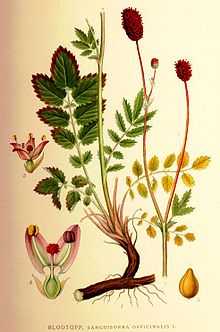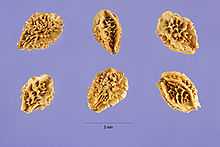Sanguisorba officinalis
| Sanguisorba officinalis | |
|---|---|
 | |
| Scientific classification | |
| Kingdom: | Plantae |
| (unranked): | Angiosperms |
| (unranked): | Eudicots |
| (unranked): | Rosids |
| Order: | Rosales |
| Family: | Rosaceae |
| Genus: | Sanguisorba |
| Species: | S. officinalis |
| Binomial name | |
| Sanguisorba officinalis L. | |
Sanguisorba officinalis (great burnet) is a plant in the family Rosaceae, subfamily Rosoideae. It is native throughout the cooler regions of the Northern Hemisphere in Europe, northern Asia, and northern North America.
It is a herbaceous perennial plant growing to 1 m tall, which occurs in grasslands, growing well on grassy banks. It flowers June or July.[1]
Sanguisorba officinalis is an important food plant for the European large blue butterflies Maculinea nausithous and M. teleius.[2]
Commercial Uses

Use is made of its extensive root system for erosion control, as well as a bioremediator, used to reclaim derelict sites such as landfills.
The leaves are used in salads because they are mildly reminiscent of cucumber. Selective pruning of apical meristems, such as at flower heads, is used to encourage an increase in leaf production.
Ethnomedical uses
It has been used in Traditional Chinese Medicine (TCM) where it is known by the name Di Yu. It is said to cool the blood, stop bleeding, clear heat, and heal wounds. (Chinese Herbal Materia Medica by Dan Bensky)
Specifically, the root is used to stop bloody dysentery, nosebleeds, and is applied topically to treat burns and insect bites.[citation needed]
Chemistry
Sanguiin H-6 is a dimeric ellagitannin that can be found in S. officinalis.[3]
References
- ↑ Plants for a Future: Sanguisorba officinalis
- ↑ World Conservation Monitoring Centre 1996. Maculinea nausithous. 2006 IUCN Red List of Threatened Species. Downloaded on 6 October 2010
- ↑ Inhibition of DNA Topoisomerases by Sanguiin H-6, a Cytotoxic Dimeric Ellagitannin from Sanguisorba officinalis. K. F. Bastow, I. D. Bori, Y. Fukushima, Y. Kashiwada, T. Tanaka, G. Nonaka, I. Nishioka and K.-H. Lee, Planta Med, 1993, 59(3), pages 240-245, doi:10.1055/s-2006-959659
- Chittendon, F. RHS Dictionary of Plants plus Supplement. 1956 Oxford University Press 1951